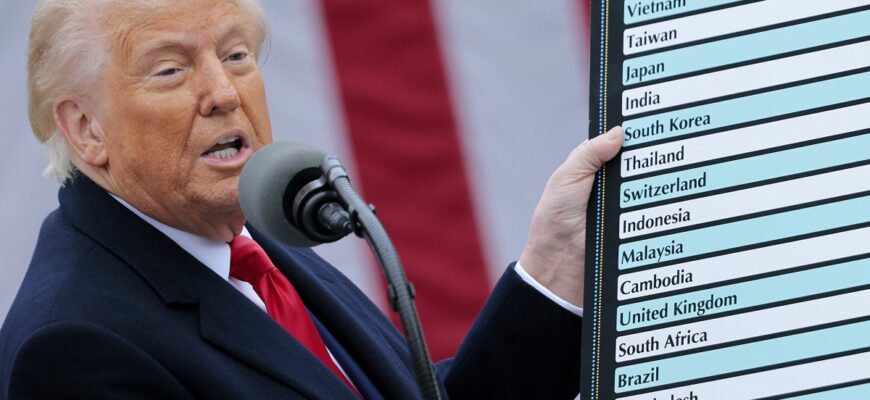Date: April 4, 2025
By: TheMors Journalists
Donald Trump is back at it, stirring the pot of global trade. On April 2, 2025, the US President dropped a bombshell from the White House: a 10% tariff on every single item shipped into the United States from overseas. But that’s just the start. For the European Union, the duty jumps to 20%, while China gets hit with a staggering 34%. Russia, oddly enough, didn’t make the cut for this round of penalties. With these changes kicking in soon—April 5 for the baseline and April 9 for the EU and others—the world’s watching to see what happens next.
We’re the team at TheMors, and we’ve pulled together this guide to unpack Trump’s latest trade shake-up. Whether you’re searching for “Trump’s EU tariffs 20%”, “new US import duties 2025,” or just wondering how this affects your shopping cart, we’ve got the details you need. Drawing from sources like Reuters, The Guardian, Bloomberg, and AP News, here’s what’s going down and why it matters to you.
Trump’s Latest Trade Move: The Basics
Picture this: Trump steps out into the Rose Garden, flanked by aides, and lays out his plan. It’s Tuesday, April 2, 2025, and he’s calling it “Liberation Day” for American workers. Starting April 5, every imported good—from jeans to jet parts—faces a 10% tariff. Then, just days later on April 9, the EU gets a 20% duty on everything it sends to the US, and China’s imports climb to a 34% tariff wall.
Why the difference? Trump says it’s about fairness. He’s targeting countries he claims have been taking advantage of the US for years. The EU, with its $576 billion in exports to the US last year, and China, with even more, are in the crosshairs. Russia, though, stays off the list—no explanation yet from the White House. The goal, Trump insists, is to shield US jobs and force better trade deals. “They’ve been eating our lunch,” he told the crowd. “Not anymore.”
But here’s the catch: some see this as a negotiation tactic, while others think it’s a done deal. Either way, markets are jittery—European stocks took a dive on April 3, and US retailers are already rethinking their supply chains.
Breaking Down the Numbers
- Across-the-Board Tariff: 10% on all imports, starting April 5, except Canada and Mexico (already under 25% from earlier policies).
- EU Hit: 20% on all goods headed to the US, effective April 9.
- China’s Share: 34% extra, piling onto existing duties for a total of 54%.
- Russia’s Pass: No new tariffs mentioned so far.
- Scope: Everything from cars to cheese, no exceptions listed yet.
What Do These Tariffs Mean for Everyday People?
Trump’s tariffs aren’t just numbers on a page—they’ll ripple through wallets, stores, and factories. Here’s how they could shake things up for you, whether you’re in the US or across the pond.
For Americans Buying Stuff
Love your German beer or Italian leather shoes? Get ready to pay more. That 20% EU tariff gets tacked on by importers, and guess who they’ll pass it to? You. Here’s a quick look:
- A $30,000 Volkswagen might climb to $36,000.
- A $15 Spanish ham could nudge up to $18.
The US imported $2.6 trillion in goods last year, per the Census Bureau, with the EU making up a big chunk. Economists say this could bump up inflation—already a sore spot after 2024’s rocky recovery. Your grocery bill or next car purchase might feel the pinch sooner than you’d like.
For EU Companies and Jobs
Over in Europe, businesses that rely on the US market are sweating. Take Germany’s carmakers—BMW and Mercedes shipped over 300,000 vehicles to the US in 2024. A 20% tariff could slash their profits or force price hikes, risking sales. Smaller players, like a Dutch cheese maker interviewed by Bloomberg, are even more vulnerable. “We’ve spent years building our US customers,” said Jan Visser. “This could wipe us out.”
The European Trade Union Confederation warns of job cuts, especially in export hubs like Bavaria or Tuscany. If sales tank, layoffs might follow.
Beyond the Borders
This isn’t just an EU-US issue. Higher costs could ripple globally. If EU goods get pricier in the US, American buyers might turn to places like Japan or Brazil instead. Meanwhile, the EU’s already hinting at striking back—more on that in a bit.
Why Pick on the EU with a 20% Tariff?
Trump didn’t pull that 20% figure out of thin air. He’s zeroed in on the EU’s $200 billion trade surplus with the US last year. His beef? The EU charges 10% on US cars while the US only asks 2.5% for theirs. Add in gripes about EU farm subsidies and tech taxes, and Trump’s team sees a pattern of “unfairness.”
Still, the math doesn’t fully add up. The EU’s overall tariff average is around 5%, way below Trump’s new rates. Some experts, like trade analyst Maria Delgado quoted by AP News, argue this is less about tariffs and more about politics—Trump flexing muscle to rally his base. Whatever the reason, the EU’s caught in the middle.
What’s the EU Planning to Do?
Europe’s leaders aren’t sitting quietly. On April 3, Ursula von der Leyen, head of the European Commission, called Trump’s tariffs a “direct attack on open trade” and vowed a response. She’s pushing for talks with US Trade Representative Katherine Tai, hoping to soften the blow before April 9. But if that fails, retaliation’s on the table—think duties on US whiskey, jeans, or apples, echoing the EU’s playbook from Trump’s steel tariffs last month.
Germany’s Olaf Scholz chimed in, urging a “joint European stance” to avoid a trade spiral. France’s Macron went further, suggesting a freeze on new French investments in the US if the tariffs stick. The message is clear: the EU’s ready to push back if Trump doesn’t blink.
Possible Outcomes
- A Deal: The EU cuts some tariffs, and Trump eases up on the 20%. Talks are set for April 6 in Brussels.
- Escalation: The EU hits back with its own duties, and trade tensions boil over.
- Standoff: Both sides dig in, and prices climb as businesses scramble.
How Are Companies Handling This?
Businesses aren’t waiting to see who flinches first. US retailers like Walmart are rushing EU shipments before April 9, piling warehouses with French wine and German tools. Across the Atlantic, Audi’s already tweaking prices on its US models to cushion the 25% car tariff that started April 3, per The Guardian.
But not everyone can pivot so easily. A small Irish knitwear company told Reuters they’re stuck—too tiny to absorb a 20% hit or shift markets overnight. It’s a tale of two realities: big firms adapt, smaller ones brace for impact.
Russia’s Curious Exemption
Here’s a head-scratcher: Russia dodged the tariff bullet. With no mention from Trump, its exports—like gas or aluminum—keep flowing under old rules. Some whisper it’s a nod to Trump’s softer line on Moscow, though his team’s stayed mum. For now, Russia watches from the sidelines while the EU and China take the heat.
Why Should You Care?
These tariffs could change how you shop, work, or even invest. If you’re in the US, that next European vacation souvenir might cost more. If you’re in the EU, your job could feel the strain if exports dry up. And globally, a trade war means uncertainty—something markets hate.
We’ve pieced this together at TheMors using the latest from Reuters, The Guardian, Bloomberg, and AP News. It’s a fast-moving story, and we’re on it—bringing you what you need without the clutter.
FAQ: Quick Answers on Trump’s Tariffs
What’s the 20% EU tariff about?
It’s a new duty on all EU goods entering the US, starting April 9, 2025, on top of a 10% base tariff.
Why is Trump doing this?
He says it protects US jobs and counters the EU’s trade surplus and higher tariffs on American goods.
Will prices go up in the US?
Yes, EU imports like cars and food could rise 20% or more as costs trickle down.
Is the EU fighting back?
They’re trying to negotiate but prepping tariffs on US goods if talks flop.
Why no tariffs on Russia?
Trump didn’t say, leaving speculation about political ties—no hard answers yet.
Stay in the Loop with TheMors
Trump’s 20% tariffs on EU imports are shaking things up, and the fallout’s just beginning. Want more on how this plays out for prices, jobs, or global trade? Swing by TheMors – Breaking News. Our journalists are digging into trade shifts, political moves, and more—stuff that matters to you. Drop in today for the full scoop!









